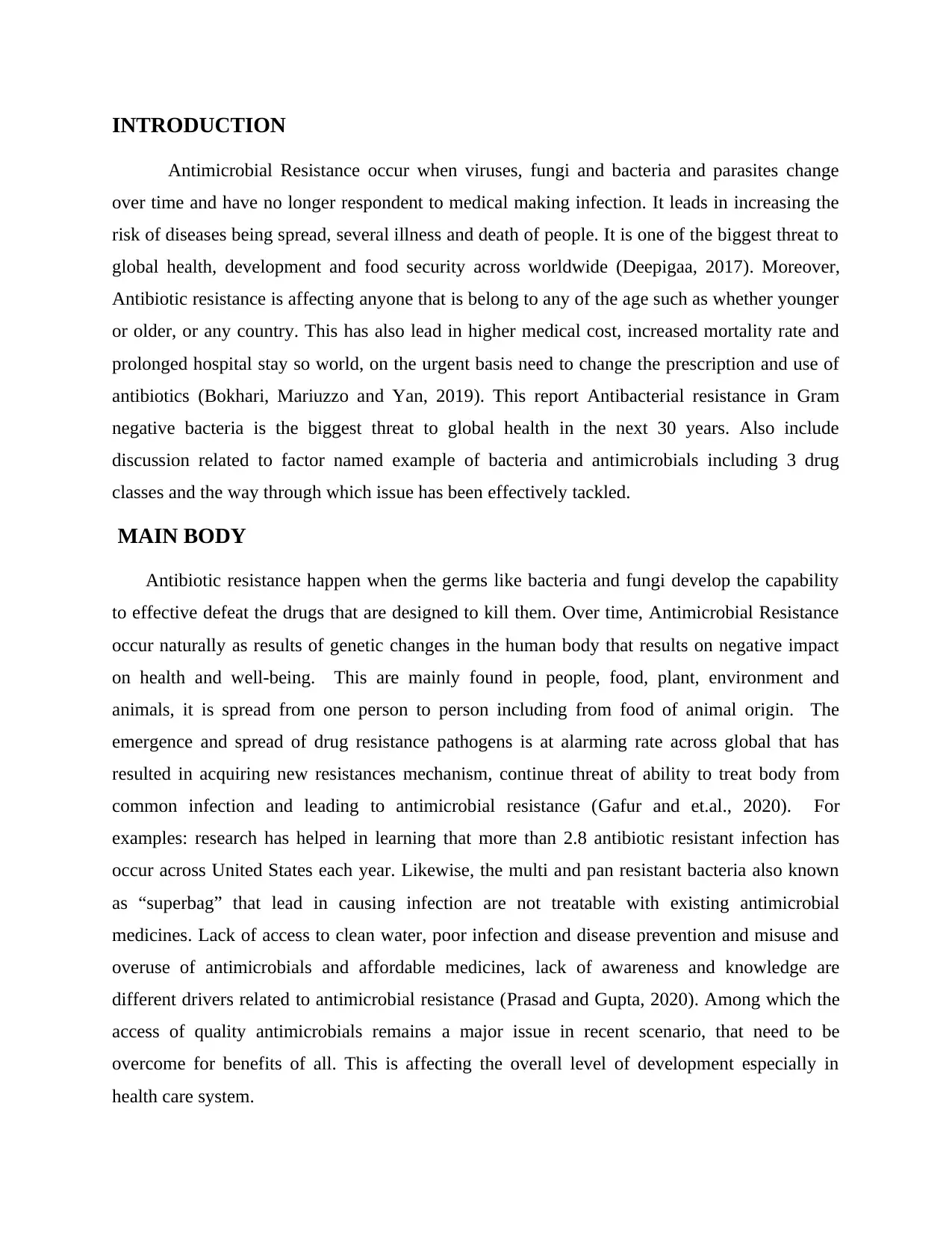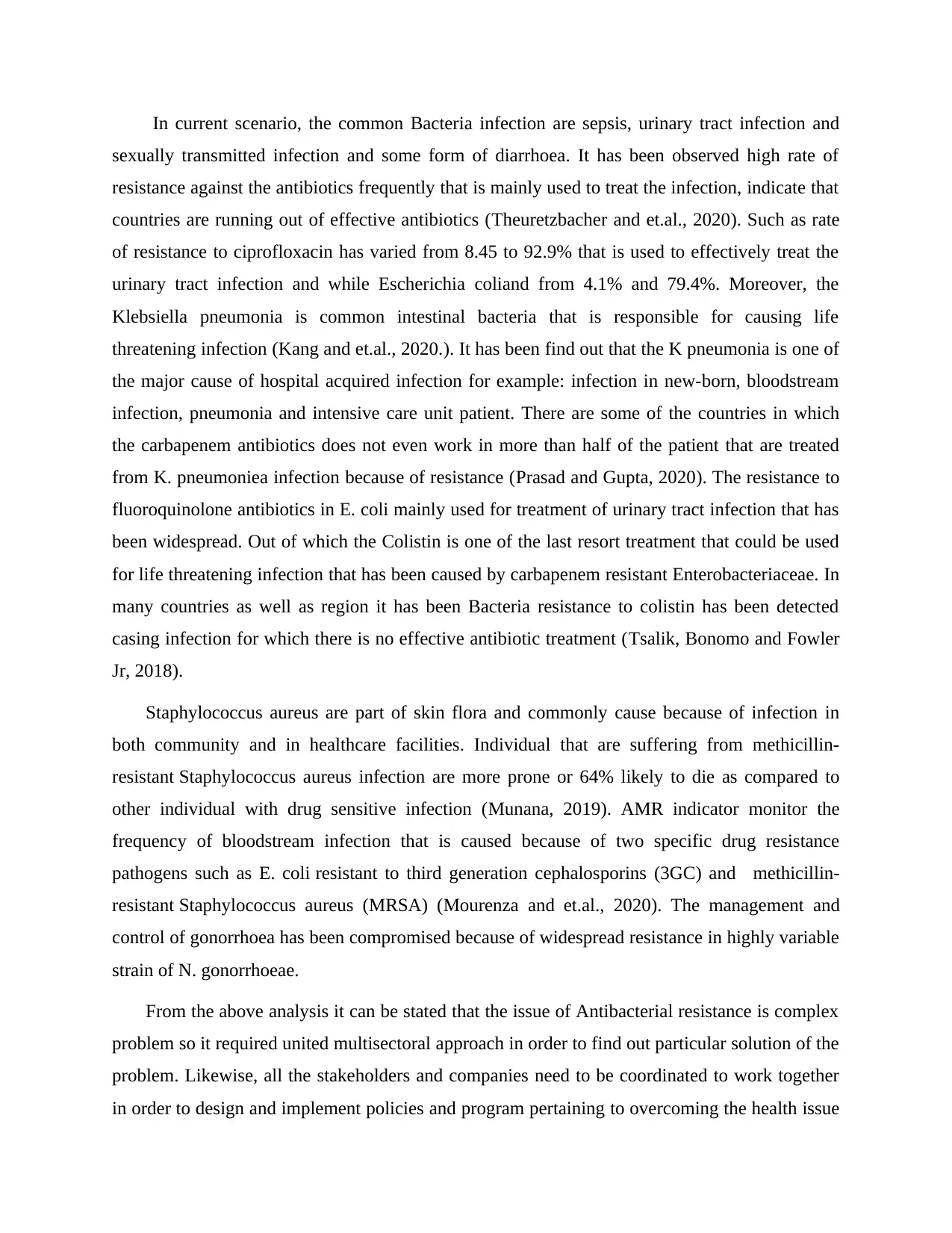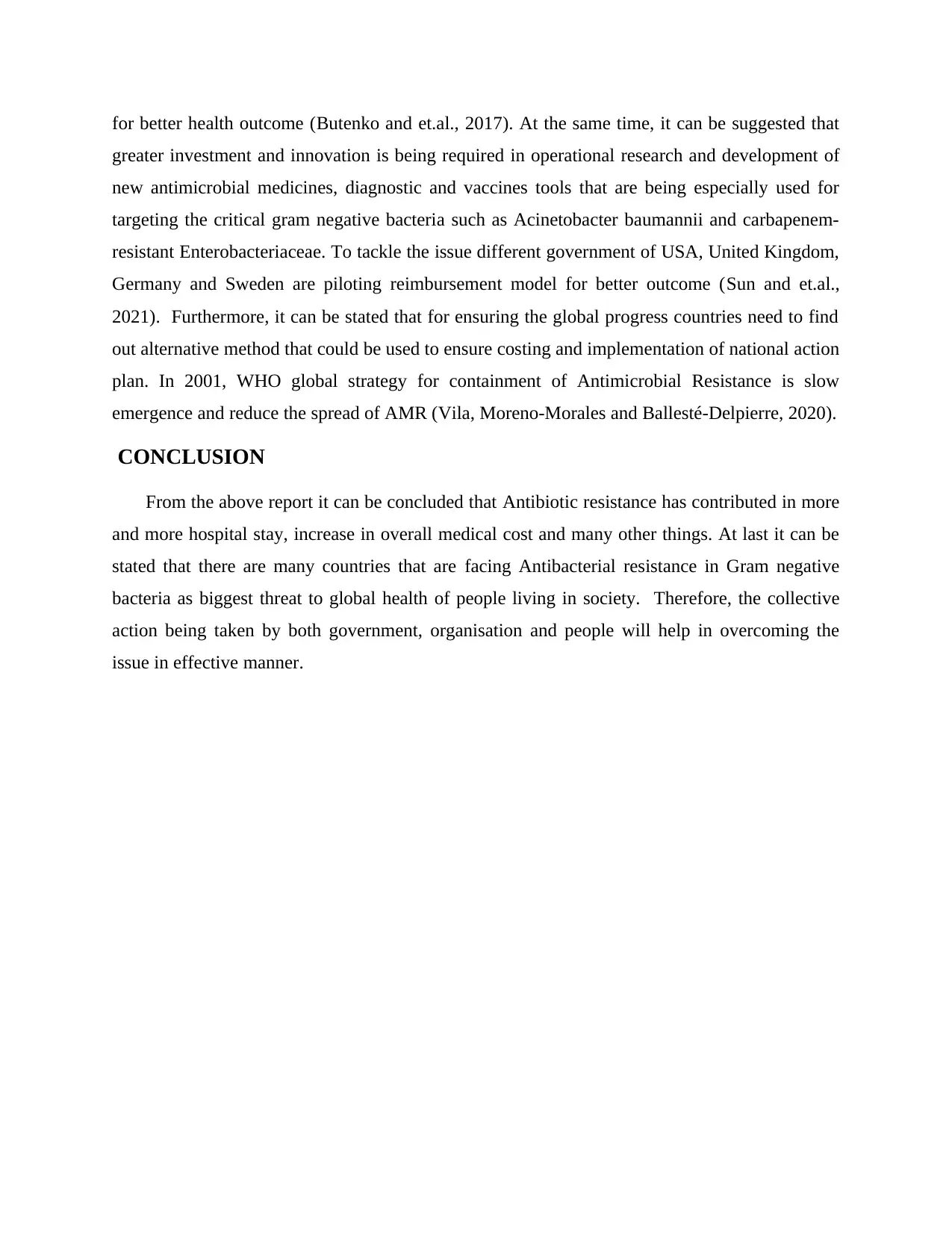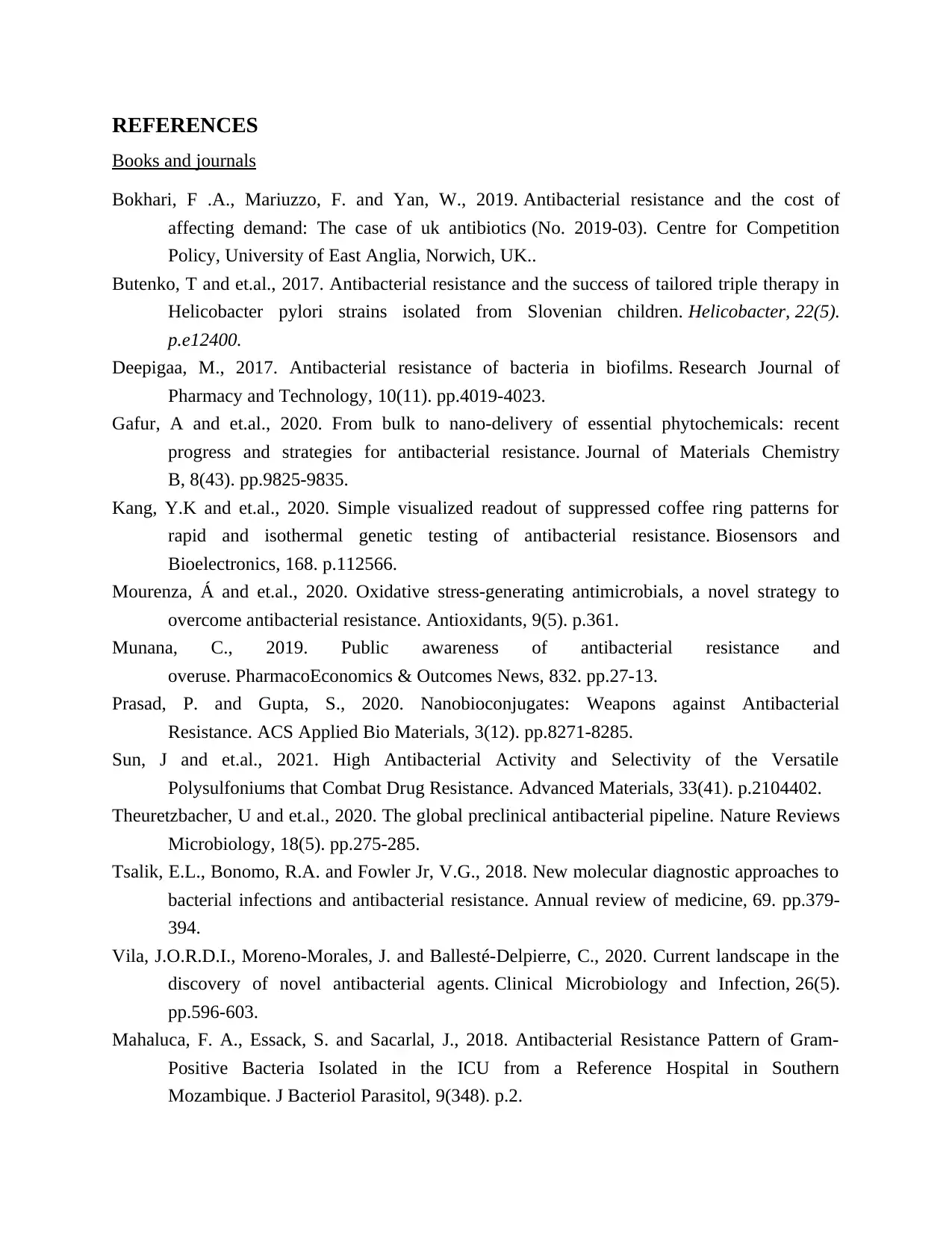Gram-Negative Bacteria Antibacterial Resistance: Global Health Report
VerifiedAdded on 2023/06/15
|7
|1609
|228
Report
AI Summary
This report examines the growing issue of antibacterial resistance, focusing on Gram-negative bacteria and its implications for global health. It highlights the natural development of antimicrobial resistance due to genetic changes and its spread through various channels, including humans, animals, and the environment. The report cites examples of antibiotic-resistant infections, such as urinary tract infections and sepsis, and discusses the misuse and overuse of antimicrobials as key drivers of resistance. Specific bacteria like Escherichia coli and Klebsiella pneumoniae are mentioned, along with their resistance to common antibiotics. The report emphasizes the need for a united, multisectoral approach, including greater investment in research and development, to combat antibacterial resistance effectively. It also references the WHO's global strategy for containment of antimicrobial resistance and the importance of collective action by governments, organizations, and individuals to address this critical health challenge. Desklib provides students access to similar solved assignments and resources.

ANTIBACTERIAL RESISTANCE
Paraphrase This Document
Need a fresh take? Get an instant paraphrase of this document with our AI Paraphraser

TABLE OF CONTENTS
INTRODUCTION...........................................................................................................................3
MAIN BODY...................................................................................................................................3
CONCLUSION................................................................................................................................5
REFERENCES................................................................................................................................6
INTRODUCTION...........................................................................................................................3
MAIN BODY...................................................................................................................................3
CONCLUSION................................................................................................................................5
REFERENCES................................................................................................................................6

INTRODUCTION
Antimicrobial Resistance occur when viruses, fungi and bacteria and parasites change
over time and have no longer respondent to medical making infection. It leads in increasing the
risk of diseases being spread, several illness and death of people. It is one of the biggest threat to
global health, development and food security across worldwide (Deepigaa, 2017). Moreover,
Antibiotic resistance is affecting anyone that is belong to any of the age such as whether younger
or older, or any country. This has also lead in higher medical cost, increased mortality rate and
prolonged hospital stay so world, on the urgent basis need to change the prescription and use of
antibiotics (Bokhari, Mariuzzo and Yan, 2019). This report Antibacterial resistance in Gram
negative bacteria is the biggest threat to global health in the next 30 years. Also include
discussion related to factor named example of bacteria and antimicrobials including 3 drug
classes and the way through which issue has been effectively tackled.
MAIN BODY
Antibiotic resistance happen when the germs like bacteria and fungi develop the capability
to effective defeat the drugs that are designed to kill them. Over time, Antimicrobial Resistance
occur naturally as results of genetic changes in the human body that results on negative impact
on health and well-being. This are mainly found in people, food, plant, environment and
animals, it is spread from one person to person including from food of animal origin. The
emergence and spread of drug resistance pathogens is at alarming rate across global that has
resulted in acquiring new resistances mechanism, continue threat of ability to treat body from
common infection and leading to antimicrobial resistance (Gafur and et.al., 2020). For
examples: research has helped in learning that more than 2.8 antibiotic resistant infection has
occur across United States each year. Likewise, the multi and pan resistant bacteria also known
as “superbag” that lead in causing infection are not treatable with existing antimicrobial
medicines. Lack of access to clean water, poor infection and disease prevention and misuse and
overuse of antimicrobials and affordable medicines, lack of awareness and knowledge are
different drivers related to antimicrobial resistance (Prasad and Gupta, 2020). Among which the
access of quality antimicrobials remains a major issue in recent scenario, that need to be
overcome for benefits of all. This is affecting the overall level of development especially in
health care system.
Antimicrobial Resistance occur when viruses, fungi and bacteria and parasites change
over time and have no longer respondent to medical making infection. It leads in increasing the
risk of diseases being spread, several illness and death of people. It is one of the biggest threat to
global health, development and food security across worldwide (Deepigaa, 2017). Moreover,
Antibiotic resistance is affecting anyone that is belong to any of the age such as whether younger
or older, or any country. This has also lead in higher medical cost, increased mortality rate and
prolonged hospital stay so world, on the urgent basis need to change the prescription and use of
antibiotics (Bokhari, Mariuzzo and Yan, 2019). This report Antibacterial resistance in Gram
negative bacteria is the biggest threat to global health in the next 30 years. Also include
discussion related to factor named example of bacteria and antimicrobials including 3 drug
classes and the way through which issue has been effectively tackled.
MAIN BODY
Antibiotic resistance happen when the germs like bacteria and fungi develop the capability
to effective defeat the drugs that are designed to kill them. Over time, Antimicrobial Resistance
occur naturally as results of genetic changes in the human body that results on negative impact
on health and well-being. This are mainly found in people, food, plant, environment and
animals, it is spread from one person to person including from food of animal origin. The
emergence and spread of drug resistance pathogens is at alarming rate across global that has
resulted in acquiring new resistances mechanism, continue threat of ability to treat body from
common infection and leading to antimicrobial resistance (Gafur and et.al., 2020). For
examples: research has helped in learning that more than 2.8 antibiotic resistant infection has
occur across United States each year. Likewise, the multi and pan resistant bacteria also known
as “superbag” that lead in causing infection are not treatable with existing antimicrobial
medicines. Lack of access to clean water, poor infection and disease prevention and misuse and
overuse of antimicrobials and affordable medicines, lack of awareness and knowledge are
different drivers related to antimicrobial resistance (Prasad and Gupta, 2020). Among which the
access of quality antimicrobials remains a major issue in recent scenario, that need to be
overcome for benefits of all. This is affecting the overall level of development especially in
health care system.
⊘ This is a preview!⊘
Do you want full access?
Subscribe today to unlock all pages.

Trusted by 1+ million students worldwide

In current scenario, the common Bacteria infection are sepsis, urinary tract infection and
sexually transmitted infection and some form of diarrhoea. It has been observed high rate of
resistance against the antibiotics frequently that is mainly used to treat the infection, indicate that
countries are running out of effective antibiotics (Theuretzbacher and et.al., 2020). Such as rate
of resistance to ciprofloxacin has varied from 8.45 to 92.9% that is used to effectively treat the
urinary tract infection and while Escherichia coliand from 4.1% and 79.4%. Moreover, the
Klebsiella pneumonia is common intestinal bacteria that is responsible for causing life
threatening infection (Kang and et.al., 2020.). It has been find out that the K pneumonia is one of
the major cause of hospital acquired infection for example: infection in new-born, bloodstream
infection, pneumonia and intensive care unit patient. There are some of the countries in which
the carbapenem antibiotics does not even work in more than half of the patient that are treated
from K. pneumoniea infection because of resistance (Prasad and Gupta, 2020). The resistance to
fluoroquinolone antibiotics in E. coli mainly used for treatment of urinary tract infection that has
been widespread. Out of which the Colistin is one of the last resort treatment that could be used
for life threatening infection that has been caused by carbapenem resistant Enterobacteriaceae. In
many countries as well as region it has been Bacteria resistance to colistin has been detected
casing infection for which there is no effective antibiotic treatment (Tsalik, Bonomo and Fowler
Jr, 2018).
Staphylococcus aureus are part of skin flora and commonly cause because of infection in
both community and in healthcare facilities. Individual that are suffering from methicillin-
resistant Staphylococcus aureus infection are more prone or 64% likely to die as compared to
other individual with drug sensitive infection (Munana, 2019). AMR indicator monitor the
frequency of bloodstream infection that is caused because of two specific drug resistance
pathogens such as E. coli resistant to third generation cephalosporins (3GC) and methicillin-
resistant Staphylococcus aureus (MRSA) (Mourenza and et.al., 2020). The management and
control of gonorrhoea has been compromised because of widespread resistance in highly variable
strain of N. gonorrhoeae.
From the above analysis it can be stated that the issue of Antibacterial resistance is complex
problem so it required united multisectoral approach in order to find out particular solution of the
problem. Likewise, all the stakeholders and companies need to be coordinated to work together
in order to design and implement policies and program pertaining to overcoming the health issue
sexually transmitted infection and some form of diarrhoea. It has been observed high rate of
resistance against the antibiotics frequently that is mainly used to treat the infection, indicate that
countries are running out of effective antibiotics (Theuretzbacher and et.al., 2020). Such as rate
of resistance to ciprofloxacin has varied from 8.45 to 92.9% that is used to effectively treat the
urinary tract infection and while Escherichia coliand from 4.1% and 79.4%. Moreover, the
Klebsiella pneumonia is common intestinal bacteria that is responsible for causing life
threatening infection (Kang and et.al., 2020.). It has been find out that the K pneumonia is one of
the major cause of hospital acquired infection for example: infection in new-born, bloodstream
infection, pneumonia and intensive care unit patient. There are some of the countries in which
the carbapenem antibiotics does not even work in more than half of the patient that are treated
from K. pneumoniea infection because of resistance (Prasad and Gupta, 2020). The resistance to
fluoroquinolone antibiotics in E. coli mainly used for treatment of urinary tract infection that has
been widespread. Out of which the Colistin is one of the last resort treatment that could be used
for life threatening infection that has been caused by carbapenem resistant Enterobacteriaceae. In
many countries as well as region it has been Bacteria resistance to colistin has been detected
casing infection for which there is no effective antibiotic treatment (Tsalik, Bonomo and Fowler
Jr, 2018).
Staphylococcus aureus are part of skin flora and commonly cause because of infection in
both community and in healthcare facilities. Individual that are suffering from methicillin-
resistant Staphylococcus aureus infection are more prone or 64% likely to die as compared to
other individual with drug sensitive infection (Munana, 2019). AMR indicator monitor the
frequency of bloodstream infection that is caused because of two specific drug resistance
pathogens such as E. coli resistant to third generation cephalosporins (3GC) and methicillin-
resistant Staphylococcus aureus (MRSA) (Mourenza and et.al., 2020). The management and
control of gonorrhoea has been compromised because of widespread resistance in highly variable
strain of N. gonorrhoeae.
From the above analysis it can be stated that the issue of Antibacterial resistance is complex
problem so it required united multisectoral approach in order to find out particular solution of the
problem. Likewise, all the stakeholders and companies need to be coordinated to work together
in order to design and implement policies and program pertaining to overcoming the health issue
Paraphrase This Document
Need a fresh take? Get an instant paraphrase of this document with our AI Paraphraser

for better health outcome (Butenko and et.al., 2017). At the same time, it can be suggested that
greater investment and innovation is being required in operational research and development of
new antimicrobial medicines, diagnostic and vaccines tools that are being especially used for
targeting the critical gram negative bacteria such as Acinetobacter baumannii and carbapenem-
resistant Enterobacteriaceae. To tackle the issue different government of USA, United Kingdom,
Germany and Sweden are piloting reimbursement model for better outcome (Sun and et.al.,
2021). Furthermore, it can be stated that for ensuring the global progress countries need to find
out alternative method that could be used to ensure costing and implementation of national action
plan. In 2001, WHO global strategy for containment of Antimicrobial Resistance is slow
emergence and reduce the spread of AMR (Vila, Moreno-Morales and Ballesté-Delpierre, 2020).
CONCLUSION
From the above report it can be concluded that Antibiotic resistance has contributed in more
and more hospital stay, increase in overall medical cost and many other things. At last it can be
stated that there are many countries that are facing Antibacterial resistance in Gram negative
bacteria as biggest threat to global health of people living in society. Therefore, the collective
action being taken by both government, organisation and people will help in overcoming the
issue in effective manner.
greater investment and innovation is being required in operational research and development of
new antimicrobial medicines, diagnostic and vaccines tools that are being especially used for
targeting the critical gram negative bacteria such as Acinetobacter baumannii and carbapenem-
resistant Enterobacteriaceae. To tackle the issue different government of USA, United Kingdom,
Germany and Sweden are piloting reimbursement model for better outcome (Sun and et.al.,
2021). Furthermore, it can be stated that for ensuring the global progress countries need to find
out alternative method that could be used to ensure costing and implementation of national action
plan. In 2001, WHO global strategy for containment of Antimicrobial Resistance is slow
emergence and reduce the spread of AMR (Vila, Moreno-Morales and Ballesté-Delpierre, 2020).
CONCLUSION
From the above report it can be concluded that Antibiotic resistance has contributed in more
and more hospital stay, increase in overall medical cost and many other things. At last it can be
stated that there are many countries that are facing Antibacterial resistance in Gram negative
bacteria as biggest threat to global health of people living in society. Therefore, the collective
action being taken by both government, organisation and people will help in overcoming the
issue in effective manner.

REFERENCES
Books and journals
Bokhari, F .A., Mariuzzo, F. and Yan, W., 2019. Antibacterial resistance and the cost of
affecting demand: The case of uk antibiotics (No. 2019-03). Centre for Competition
Policy, University of East Anglia, Norwich, UK..
Butenko, T and et.al., 2017. Antibacterial resistance and the success of tailored triple therapy in
Helicobacter pylori strains isolated from Slovenian children. Helicobacter, 22(5).
p.e12400.
Deepigaa, M., 2017. Antibacterial resistance of bacteria in biofilms. Research Journal of
Pharmacy and Technology, 10(11). pp.4019-4023.
Gafur, A and et.al., 2020. From bulk to nano-delivery of essential phytochemicals: recent
progress and strategies for antibacterial resistance. Journal of Materials Chemistry
B, 8(43). pp.9825-9835.
Kang, Y.K and et.al., 2020. Simple visualized readout of suppressed coffee ring patterns for
rapid and isothermal genetic testing of antibacterial resistance. Biosensors and
Bioelectronics, 168. p.112566.
Mourenza, Á and et.al., 2020. Oxidative stress-generating antimicrobials, a novel strategy to
overcome antibacterial resistance. Antioxidants, 9(5). p.361.
Munana, C., 2019. Public awareness of antibacterial resistance and
overuse. PharmacoEconomics & Outcomes News, 832. pp.27-13.
Prasad, P. and Gupta, S., 2020. Nanobioconjugates: Weapons against Antibacterial
Resistance. ACS Applied Bio Materials, 3(12). pp.8271-8285.
Sun, J and et.al., 2021. High Antibacterial Activity and Selectivity of the Versatile
Polysulfoniums that Combat Drug Resistance. Advanced Materials, 33(41). p.2104402.
Theuretzbacher, U and et.al., 2020. The global preclinical antibacterial pipeline. Nature Reviews
Microbiology, 18(5). pp.275-285.
Tsalik, E.L., Bonomo, R.A. and Fowler Jr, V.G., 2018. New molecular diagnostic approaches to
bacterial infections and antibacterial resistance. Annual review of medicine, 69. pp.379-
394.
Vila, J.O.R.D.I., Moreno-Morales, J. and Ballesté-Delpierre, C., 2020. Current landscape in the
discovery of novel antibacterial agents. Clinical Microbiology and Infection, 26(5).
pp.596-603.
Mahaluca, F. A., Essack, S. and Sacarlal, J., 2018. Antibacterial Resistance Pattern of Gram-
Positive Bacteria Isolated in the ICU from a Reference Hospital in Southern
Mozambique. J Bacteriol Parasitol, 9(348). p.2.
Books and journals
Bokhari, F .A., Mariuzzo, F. and Yan, W., 2019. Antibacterial resistance and the cost of
affecting demand: The case of uk antibiotics (No. 2019-03). Centre for Competition
Policy, University of East Anglia, Norwich, UK..
Butenko, T and et.al., 2017. Antibacterial resistance and the success of tailored triple therapy in
Helicobacter pylori strains isolated from Slovenian children. Helicobacter, 22(5).
p.e12400.
Deepigaa, M., 2017. Antibacterial resistance of bacteria in biofilms. Research Journal of
Pharmacy and Technology, 10(11). pp.4019-4023.
Gafur, A and et.al., 2020. From bulk to nano-delivery of essential phytochemicals: recent
progress and strategies for antibacterial resistance. Journal of Materials Chemistry
B, 8(43). pp.9825-9835.
Kang, Y.K and et.al., 2020. Simple visualized readout of suppressed coffee ring patterns for
rapid and isothermal genetic testing of antibacterial resistance. Biosensors and
Bioelectronics, 168. p.112566.
Mourenza, Á and et.al., 2020. Oxidative stress-generating antimicrobials, a novel strategy to
overcome antibacterial resistance. Antioxidants, 9(5). p.361.
Munana, C., 2019. Public awareness of antibacterial resistance and
overuse. PharmacoEconomics & Outcomes News, 832. pp.27-13.
Prasad, P. and Gupta, S., 2020. Nanobioconjugates: Weapons against Antibacterial
Resistance. ACS Applied Bio Materials, 3(12). pp.8271-8285.
Sun, J and et.al., 2021. High Antibacterial Activity and Selectivity of the Versatile
Polysulfoniums that Combat Drug Resistance. Advanced Materials, 33(41). p.2104402.
Theuretzbacher, U and et.al., 2020. The global preclinical antibacterial pipeline. Nature Reviews
Microbiology, 18(5). pp.275-285.
Tsalik, E.L., Bonomo, R.A. and Fowler Jr, V.G., 2018. New molecular diagnostic approaches to
bacterial infections and antibacterial resistance. Annual review of medicine, 69. pp.379-
394.
Vila, J.O.R.D.I., Moreno-Morales, J. and Ballesté-Delpierre, C., 2020. Current landscape in the
discovery of novel antibacterial agents. Clinical Microbiology and Infection, 26(5).
pp.596-603.
Mahaluca, F. A., Essack, S. and Sacarlal, J., 2018. Antibacterial Resistance Pattern of Gram-
Positive Bacteria Isolated in the ICU from a Reference Hospital in Southern
Mozambique. J Bacteriol Parasitol, 9(348). p.2.
⊘ This is a preview!⊘
Do you want full access?
Subscribe today to unlock all pages.

Trusted by 1+ million students worldwide

7
1 out of 7
Related Documents
Your All-in-One AI-Powered Toolkit for Academic Success.
+13062052269
info@desklib.com
Available 24*7 on WhatsApp / Email
![[object Object]](/_next/static/media/star-bottom.7253800d.svg)
Unlock your academic potential
Copyright © 2020–2025 A2Z Services. All Rights Reserved. Developed and managed by ZUCOL.




